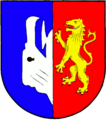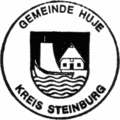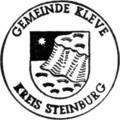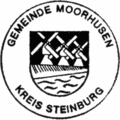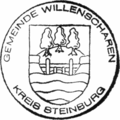Coats of arms in Schleswig-Holstein approved by the British Military Government
After the Second World War , the communities in the British occupation zone that did not have their own coat of arms were no longer allowed to use the official seals with the National Socialist imperial eagle and swastika in an oak wreath that had been used until then . The use of the Prussian eagle and other symbols reminiscent of the German Empire was also undesirable.
The Upper President of the Province of Schleswig-Holstein therefore recommended in January 1946 the adoption of seals with local symbols. The British Military Government reserved the approval . It took place informally, i. H. without blazon and historical justification. Most of these pictorial seals did not follow the strict heraldic rules, so that one cannot actually speak of coats of arms , although they have the outer shape due to the shield and were probably intended as such.
According to current knowledge, it can be assumed that most of the municipalities - depending on the regional location - chose the Holsteiner Nesselblatt or the Schleswig lions as their motif before they switched to the Schleswig-Holstein coat of arms from April 1947 - after the legal prerequisites were created. To choose Holsteins as a symbol. However, individual seals have also been in use. The exact number can no longer be determined today.
In the 1990s, the Schleswig-Holstein State Archives conducted a survey of the district administrations to determine which municipalities still use coats of arms or seals approved by the British military government that are not known to the State Archives. It was found that these are the communities Bosau , Malente , Ratekau and Steinfeld as well as Bekdorf , Huje , Kleve , Krummendiek , Moorhusen , Oldendorf and Willenscharen . The coats of arms of the first four municipalities were heraldically correct as far as possible and could be entered in the municipal coat of arms at the state archive with blazon and historical reasons .
The seals of the seven last-mentioned communities - all located in the Steinburg district - cannot be heraldically described. It is also not clear today whether the tinging was the original, or whether it was added or changed afterwards. These “coats of arms” were also included in the roll of coats of arms, but without illustration, blazon and historical justification, and with the note that they are not coats of arms in the actual sense, but rather an image seal.
- Seal and "coat of arms" of the seven Steinburg communities
literature
Martin Reissmann: The coats of arms of the districts, offices, cities and communities in Schleswig-Holstein / edit. by Martin Reissmann with co-worker from Uta Hess. Husum 1997 (publications by the Schleswig-Holstein State Archives; 49). ISBN 3-88042-815-8 ; P. 379 ff.
